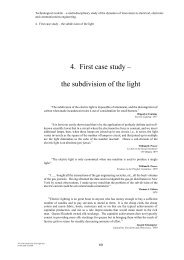Valuation Techniques for Social Cost-Benefit Analysis: - HM Treasury
Valuation Techniques for Social Cost-Benefit Analysis: - HM Treasury
Valuation Techniques for Social Cost-Benefit Analysis: - HM Treasury
Create successful ePaper yourself
Turn your PDF publications into a flip-book with our unique Google optimized e-Paper software.
58<br />
Regardless of the elicitation <strong>for</strong>mat adopted, respondents should always be reminded of their<br />
budget constraint (Bateman et al, 2002, p.143). This is to help ensure that respondents perceive<br />
the questions as real economic choices.<br />
The Design of Choice Modelling Questionnaires<br />
Choice modelling questionnaires are typically structured in much the same way as contingent<br />
valuation questionnaires (see, <strong>for</strong> example, Tuan and Navrud, 2006). The difference between the<br />
two methods is that choice modelling focuses on the attributes of a non-market good (and the<br />
valuation of these attributes) instead of the whole good. By valuing attributes, choice modelling<br />
can also value the good as a whole.<br />
Most non-market goods can be described by their attributes and the levels that these attributes<br />
take. For example, Mourato et al (2005) estimate the value of different schemes to reduce the<br />
amount of sewage overflows that end up in the River Themes. Such schemes or ‗goods‘ can be<br />
described more specifically in terms of their underlying attributes. In this study, these attributes<br />
include how much the sewage reducing proposal costs (COST), the reduction in fish deaths it<br />
causes (FISH), the reduction in number of days when exposure to river quality is a health risk<br />
(HEALTH), and the reduction in visual disamenity it causes (SEWAGE). Similarly, a wetland can be<br />
described by its bird population, water quality, diversity of animal life, etc. There<strong>for</strong>e the value<br />
that individuals attach to the wetland‘s existence is determined by the values attached to the<br />
elements that describe it as a whole.<br />
All CM methods:<br />
present respondents with alternative descriptions of a good, differentiated by different<br />
levels of its attributes; then<br />
ask respondents to either rank, rate, or chose.<br />
For the latter task there are four main choice modelling methods 2 :<br />
choice experiments (‗chose‘);<br />
contingent ranking (‗rank‘);<br />
contingent rating (‗rate‘); and<br />
paired comparisons (‗chose then rate‘).<br />
Choice experiments present respondents with a series of choices between the status quo or ‗do<br />
nothing‘ option and an alternative option or options. The ‗do nothing‘ option in Mourato et al<br />
(2005) is to pay nothing annually and to bear the expected annual negative side effects (FISH,<br />
HEALTH, and SEWAGE) if no actions are taken to counter the sewage overflows. The alternative<br />
options refer to alternative descriptions of the good in question. One option may be costly but<br />
results in a large reduction in the negative sewage side effects; another may be cheap but result<br />
in a modest reduction in the negative sewage side effects.<br />
The contingent ranking approach asks respondents to rank the ‗do nothing‘ and alternative<br />
options from most to least preferred.<br />
The contingent rating approach presents respondents with a series of single alternative<br />
descriptions of the good. The respondent then has to rate the strength of their preference <strong>for</strong><br />
each description on a semantic or numeric scale.<br />
2 (Hanley, 2001).





![AIRTO [Professor Dr Brian Blunden] - HM Treasury](https://img.yumpu.com/15492848/1/184x260/airto-professor-dr-brian-blunden-hm-treasury.jpg?quality=85)










